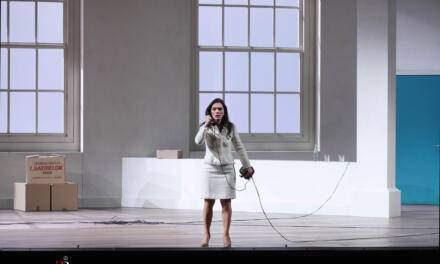My first thought upon entering Redemption Story at A.R.T./NY was that of boldness: I can’t recall the last time I saw a director—Sarah Blush, in this case—take on the challenge of traverse staging. Walking across the cast’s alleyway of playing space, one felt a marriage of discomfort and envelopment; it was easy to be sucked in to the world of Peregrine Teng Heard’s 1971 Los Angeles.
Heard’s Redemption Story follows, on its surface, two protagonists: Connie Lee (a sweeping Christine Toy Johnson) is of Hollywood renown and scandal; Billy Jay (bright-eyed José Espinosa) is of Hollywood arrival, determined to become a radioman. When the two meet in Eva’s Diner (run by Miss Eva herself, a beautifully grounded Dee Beasnael), a dynamism emerges that threatens to destroy them both…and anyone that happens to be in their crossed paths. What follows is a tale of the perils of stardom; racism, misogyny, and homophobia within entertainment; and the wrenching dynamic of a mother trying to atone.
It is a promising plotline, to be sure, and holds possibility of power and poignancy. Unfortunately, at this stage of development, the need of the play fell short. I couldn’t quite decipher what it wanted to be. A statement on representation in Hollywood? A queer love story? A semi-incestuous love story? An exploration of familial dynamic? An ensemble play, or one with clear protagonists? Is it meant to be stylized or realistic, or, if both, what is the balance? Much of what the audience should be gathering from the story is lost in this shuffle; one is not allowed to feel engrossed in any one character or community long enough to care.

Christine Toy Johnson in “Redemption Story.” PC: Travis Emery
That said, I found myself drawn to the interstitial moments. These, to my eye, were things of compelling query. The transitions between scenes, often done in low light, evoked pure, cinematic complexity. There were silhouetted figures, blinding staredowns, film noir colorization, a sense of mysticism the audience could not shake. In those moments of unreality, I felt the truest grounding of this production. For there, it’s possible to enter the minds of the characters, see what they’re feeling, understand their side. There contained a visceral communication to these moments that stuck with me long after final bows. To my view, they are the current iteration’s source of power. I yearned for more of that feeling throughout.
“Yearned” is perhaps a key descriptor for this production. I wanted more. More clarity. More play. More of secondary character interactions: Mitchell Winter, as estranged son Harrison, stole the show for me, radiating vulnerability, anger, and sadness in all their messiness. More certainty of what, precisely, they are asking of the audience. There is clearly a stunning throughline to this show. I wanted to see it.
No: I want to see it, and I can’t wait to view its eventual blossoming.
To learn more about Redemption Story, click here.
This post was written by the author in their personal capacity.The opinions expressed in this article are the author’s own and do not reflect the view of The Theatre Times, their staff or collaborators.
This post was written by Rhiannon Ling.
The views expressed here belong to the author and do not necessarily reflect our views and opinions.


















